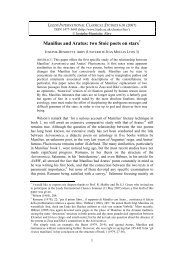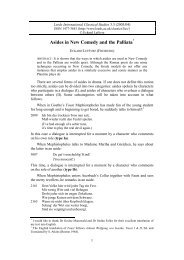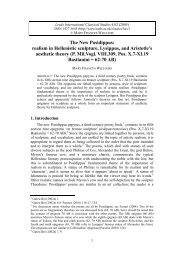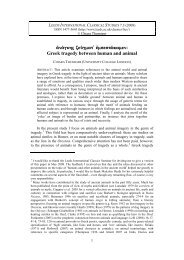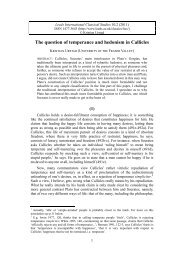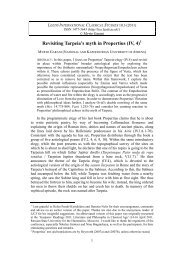Metalepsis, paragraphe and the scholia to Hermogenes - Leeds ...
Metalepsis, paragraphe and the scholia to Hermogenes - Leeds ...
Metalepsis, paragraphe and the scholia to Hermogenes - Leeds ...
You also want an ePaper? Increase the reach of your titles
YUMPU automatically turns print PDFs into web optimized ePapers that Google loves.
MALCOLM HEATH, METALEPSIS, PARAGRAPHE AND THE SCHOLIA TO HERMOGENES<br />
will not be relevant; for one cannot claim that this is not a homicide. When<br />
definition is relevant, <strong>the</strong> concomitants of definition (as <strong>the</strong> <strong>the</strong>orist says) will<br />
also be relevant. According <strong>to</strong> Minucianus <strong>the</strong>se are counterdefinition <strong>and</strong><br />
assimilation; that is as far as he goes when <strong>the</strong>y prescribe definition, on <strong>the</strong><br />
grounds that once he has assimilated <strong>and</strong> shown <strong>the</strong> identity of <strong>the</strong> defendant’s<br />
premise <strong>and</strong> his own, it is superfluous <strong>to</strong> add anything else. But when<br />
<strong>Hermogenes</strong> refers <strong>to</strong> <strong>the</strong> concomitants he means <strong>to</strong> include relative importance<br />
<strong>and</strong> importance as well, as we have said in counterplea, on <strong>the</strong> grounds that one<br />
needs not just demonstration but also amplification. Counterdefinition <strong>and</strong><br />
assimilation establish <strong>the</strong> demonstration, relative importance <strong>and</strong> importance <strong>the</strong><br />
magnitude of <strong>the</strong> crime, which is a matter of aggravation. So Minucianus, not<br />
<strong>to</strong>lerating departure from <strong>the</strong> aim of <strong>the</strong> argument, which is demonstration, once<br />
he has brought <strong>to</strong>ge<strong>the</strong>r <strong>the</strong> defendant’s premise <strong>and</strong> that of <strong>the</strong> prosecu<strong>to</strong>r, adds<br />
nothing more; but <strong>Hermogenes</strong>, when he says ‘<strong>and</strong> <strong>the</strong> concomitants of<br />
definition’ adds relative importance <strong>and</strong> importance, so that after <strong>the</strong><br />
demonstration he can give <strong>the</strong> act added weight.<br />
The positions of Minucianus <strong>and</strong> <strong>Hermogenes</strong> are summarised <strong>and</strong> <strong>the</strong>ir rationale<br />
explained in parallel form (<strong>to</strong>ÚtJ tù lÒgJ 175.27f., 176.1f.). One might feel that<br />
<strong>the</strong> repetitive summation at 176.5-12 is somewhat laboured, but <strong>the</strong> recapitulation<br />
covers both 175.26-30 <strong>and</strong> 176.1-5, so is no evidence of a combination of two<br />
sources.<br />
(iv) The fourth example comes from <strong>the</strong> discussion of <strong>the</strong> head of presentation<br />
in letter <strong>and</strong> intent. Gloeckner sees <strong>the</strong> juxtaposition of praise <strong>and</strong> criticism of<br />
<strong>Hermogenes</strong>, apparently with respect <strong>to</strong> <strong>the</strong> same point, as evidence of pro- <strong>and</strong><br />
anti-Hermogenean sources (‘Plane duorum auc<strong>to</strong>rum perlucent vestigia in p.197<br />
... ubi v. 17 <strong>Hermogenes</strong> laudatur (kalîj), v. 22 vituperatur (kakîj), quae iudicia<br />
secum pugnantia leviter consuta sunt verbis: e„dšnai d kaˆ <strong>to</strong>à<strong>to</strong> cr» (v. 21)’).<br />
In fact, <strong>the</strong> argument is single, consistent <strong>and</strong> nuanced. The text is as follows (RG<br />
5.197.17-29):<br />
kalîj p£nu prosšqhken n aÙtù e„pe‹n probolÍ ·h<strong>to</strong>à, ¢podiŽst¦j t¦j<br />
nomik¦j kaˆ t¦j logik£j. k¢ke‹ mn g£r sti probol», ¢ll' ¹ probol¾<br />
¢dik»matÒj stin x ¢gr£fou 61 eÙqunomšnou genomšnh. ntaàqa d ¹<br />
probol¾ x ggr£fou st…n. e„dšnai d kaˆ <strong>to</strong>à<strong>to</strong> cr», Óti kakîj epen<br />
probolÍ ·h<strong>to</strong>à. crÁn g¦r e„pe‹n tÍ ¢p' aÙ<strong>to</strong>à <strong>to</strong>à ·h<strong>to</strong>à. oÙd g¦r aÙtÕ<br />
tÕ ·htÕn proballÒmeqa, ¢ll¦ tÕ œgklhma tÕ di¦ ·htÕn genÒmenon. Ótan<br />
oân lšgV probolÍ ·h<strong>to</strong>à, ndeîj Ðr…zetai tÕ kef£laion: oÙd g¦r aÙtÕ<br />
mÒnon tÕ ·htÕn proballÒmeqa (po…a g¦r ¨n e‡h cre…a <strong>to</strong>‹j ge gnwkÒsi<br />
tÕ ·htÕn prote…nein;), ¢ll¦ tÕ œgklhma tÕ ¢pÕ <strong>to</strong>à ·h<strong>to</strong>à.<br />
He made an excellent addition in saying ‘presentation of <strong>the</strong> verbal instrument’,<br />
distinguishing <strong>the</strong> legal <strong>and</strong> <strong>the</strong> logical issues. There is a presentation in <strong>the</strong><br />
latter as well, but <strong>the</strong> presentation is of <strong>the</strong> crime, <strong>and</strong> arises from something<br />
non-documentary being subjected <strong>to</strong> scrutiny. But here <strong>the</strong> presentation is from<br />
<strong>the</strong> document. But one must also recognise that he was wrong <strong>to</strong> say<br />
‘presentation of <strong>the</strong> verbal instrument’: he should have said ‘based on <strong>the</strong> verbal<br />
61 ggr£fou cod.: cf. RG 4.802.6 (‘Sopater’) ~ RG 7.637.2. The latter is from <strong>the</strong> ‘patchwork’<br />
source (cf. §3.3): 7.636.24-637.7 ~ RG 4.801.22-802.2 (Syrianus) + 802.3-14 (Sopater). There is<br />
also a parallel at RG 4.813.24-814.5, in an eclectic section headed kaˆ ¥llwj ¢nwnÚmou (813.17,<br />
cf. 795.3, 845.19).<br />
26



